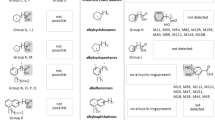Abstract
Bacterial strains were selected from a desiccated polluted soil for their drought tolerance and their ability to grow on diesel oil in view of incorporating them in a bioaugmentation product. These products are useful in case of recal citrant xenobiotic pollution, where there is no intrinsic biodegradation activity in the soil. These strains grow on the easily degradable components of diesel oil. In troduction of new catabolic genes into these desiccation-tolerant bacteria in order to improve their catabolic functions was considered.
Plasmid-borne catabolic genes coding for enzymes in volved in the degradation of more recalcitrant compounds (Isopropylbenzene, trichloroethene, 3-chloroben zoate, 4-chlorobiphenyl, biphenyl) were successfully introduced in some of the desiccation-tolerant strains by means of natural conjugation. Strains exhibiting good tolerance to desiccation and able to grow on the new carbon sources were obtained. The frequencies of integration of the plasmids ranged from 2×10−8 to 9.2 10−2 transconjugants/acceptor.
Drought-tolerance is indeed important for bioaugmentation because of its in trinsic ecological significance and because a bioaugmentation starter has to be conditioned in a desic cated form to ensure good shelf-life. The conservation of the properties during storage was evaluated by accelerated storage tests.
Similar content being viewed by others
References
Glass, D., Risto, T., and Van, Eijk J. (1995), Gen. Engineer. News 15(19), 6–9.
Weekers, F., Jacques, Ph., Springael, D., Mergeay, M., Diels, L., and Thonart Ph. (1998), Appl. Biochem. Biotech. 70–72, 311–322.
Venosa, A. D., Haines, J. R., Nisamaneepong, W., Govind, R., Prahan, R., and Siddique B. (1992), J. Ind. Microbiol. 10, 13–23.
Weekers, F., Jacques, Ph., Springael, D., Mergeay, M., Diels, L., and Thonart, Ph. (1996), Med. Fac. Landbouww. Univ. Gent, 61/4b, 2161–2164.
Marconi, A., Kieboom, J., and de Bont, J. (1997), Biotechnol. Lett. 19, 603–606.
Ramos, J., Duque, E., Huertas, M.-J., and Haidour, A. (1995), J. Bacteriol. 177(14), 3911–3916.
Straube, G., Hensel, C., Niedan, C., and Straube, E. (1990), Anthonie Van Leeuwenhoek J. Microbiol. 57, 29–32.
Ferguson, J. and Korte, F. (1981), Appl. Environ. Microbiol. 24, 7–15.
Behki, R., Top, E., Dick, W., and Germon, P. (1993), Appl. Environ. Microbiol. 59, 1955–1959.
Kobayashi, M., Nagasawa, T., and Yamadla, H. (1992), Trends Biotechnol. 10, 402–408.
Sallis, P., Armfield, S., Bull, A., and Hardman, T. (1990), J. Gen. Microbiol. 136, 115–120.
Zyltra, G. and Gibson, D. (1991), in Genetic Engineering, vol. 13., Setler, J. K., ed., Plenum Press, NY, pp. 183–203.
Weekers, F., Jacques, Ph., Springael, D., Mergeay, M., Diels, L., and Thonart, Ph. (1997), in Proceedings of the “Workshop on Extremophiles,” Dec., 7–9, 1997, Mol Belgium.
Mattimore, V. and Battista, J. R. (1996), J. Bacteriol. 178, 633–637.
Lang, E. and Malik, K. (1996), Biodegradation 7, 65–71.
Sakane, T., Banno, I., and Iijima, T. (1983), IFO Res. Comm. 11, 14–24.
Simione, F. (1992), J. Parent. Sci. Technol. 46, 226–232.
De Valdez, G., and Diekman, H. (1993), Biology 30, 185–190.
Grieff, D. and Rightsel, W. (1965), J. Immunol. 98, 895–900.
Dabrock, B., Kesseler, M., Averhoff, B., and Gottschalk, G. (1994), Appl. Environ. Microbiol. 60(3), 853–860.
Springrel, D., Kreps, S., and Merglay, M. (1993), J. Bacteriol. 175, 1674–1681.
Figursky, D., Polhman, R., Bechhofer, D., Prince, A., and Kelton, C. (1982), Proc. Natl. Acad. Sci. USA 79, 1935–1939.
Dawn, N. and Guuralus, C. (1973), J. Bacteriol. 114, 974–979.
Author information
Authors and Affiliations
Corresponding author
Rights and permissions
About this article
Cite this article
Weekers, F., Jacques, P., Springael, D. et al. Improving the catabolic functions of desiccation-tolerant soil bacteria. Appl Biochem Biotechnol 77, 251–266 (1999). https://doi.org/10.1385/ABAB:77:1-3:251
Issue Date:
DOI: https://doi.org/10.1385/ABAB:77:1-3:251




